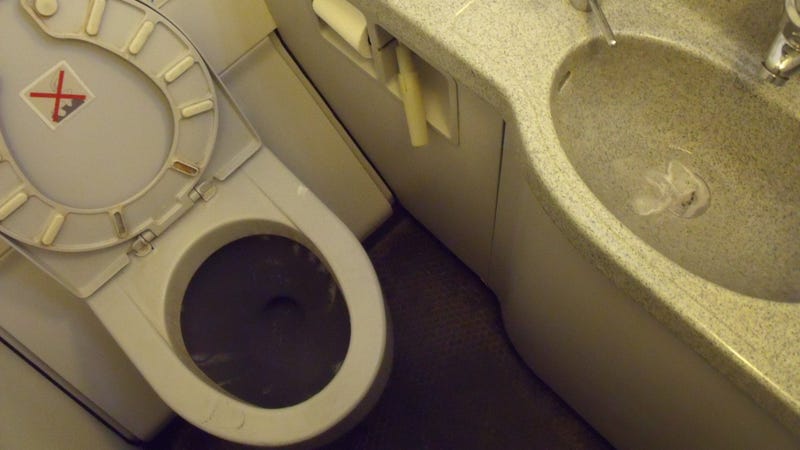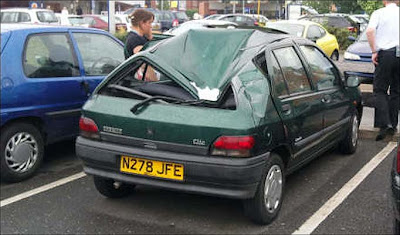Post by The Big Daddy C-Master on Oct 13, 2015 19:28:40 GMT -5
gizmodo.com/5953877/what-happens-when-you-flush-a-toilet-on-an-airplane

Aircraft lavatories have come a long way since the early days of commercial air travel. Early flyers used slop buckets, and WWII pilots tossed piss-filled bottles out of unpressurized windows (seriously).
Now, airborne waste control technology could put the Jetsons to shame. Here's what happens when you flush at 35,000 feet up.
An airplane's facilities work on a different principle than the conventional siphon toilet found in your home, and for a good reason. Siphon toilets rely on a water-filled bowl to help initiate the passive suction effect that drains them. However, without water in the bowl—either by design or due to a turbulence-induced slosh—there's nothing to flush. And since airline cabins are now pressurized, the old bucket-and-an-open-window technique won't work either. Instead, planes today rely on actively powered evacuation systems.
Through the mid-1980s, airplane toilets used Anotec, the blue deodorizing liquid you see in the bottom of Port-a-Johns, to push waste from the bowl into onboard storage tanks. Electric pumps actively drove the process, circulating fresh fluid through with every flush. While certainly a step up from buckets, these systems posed some significant drawbacks. Planes, for example, had to haul hundreds of gallons of Anotec on every flight, which increased their fuel consumption and reduced the number of passengers they could carry. In addition, early Anotec formulas were formaldehyde and bleach-based, which are severe eye and skin irritants.
Anotec's worst drawback, though, was that the systems were prone to leaking. Occassionally, these leaks would escape the hull, forming a frigid ball of shit and blue fluid on the exterior of the plane. As the aircraft dropped in altitude on its landing approach, the ball would partially thaw, break away from the craft and plummet to Earth.
When dropped from a sufficient height, frozen human excrement can be surprisingly destructive. Between 1979 and 2003, at least 27 wads of "blue ice" fell from the sky in the United States alone, impacting with enough force to tear through roofs and smash cars. Even though it was a longshot, the potential to crush an innocent person's skull with falling frozen feces was enough to convince the airline industry to develop a fluid-free alternative. So in 1975, inventor James Kemper patented the terrifyingly-loud vacuum toilets we use today.
First installed by Boeing in 1982, vacuum toilets rely on strong suction and slick walls to pull waste away using just a fraction of a gallon of water. Pressing the flush button opens a valve in the bottom of the bowl, exposing the contents to a pneumatic vacuum. That vac sucks the load down the plane's sewer line into a 200-gallon holding tank—vapors and all. A Teflon-like non-stick coating around the inside of the bowl assists in the transfer. Then, waste remains in the tank for the duration of the flight, and it's vacuumed out by crews on the ground. An exterior latch on the holding tank ensures that pilots don't accidentally drop a load in mid-air.
Surprisingly, the Kemper system has held on as the industry standard technology for 30 years now. The FAA still receives plenty of poo falling from planes reports, as if we were back in the blue ice days. But a majority of these complaints come in the fall, and always in the midst of bird migration season. So while the witnesses are correct—it is poo falling from the sky—it's just not the type of poo you can blame on the FAA.

Aircraft lavatories have come a long way since the early days of commercial air travel. Early flyers used slop buckets, and WWII pilots tossed piss-filled bottles out of unpressurized windows (seriously).
Now, airborne waste control technology could put the Jetsons to shame. Here's what happens when you flush at 35,000 feet up.
An airplane's facilities work on a different principle than the conventional siphon toilet found in your home, and for a good reason. Siphon toilets rely on a water-filled bowl to help initiate the passive suction effect that drains them. However, without water in the bowl—either by design or due to a turbulence-induced slosh—there's nothing to flush. And since airline cabins are now pressurized, the old bucket-and-an-open-window technique won't work either. Instead, planes today rely on actively powered evacuation systems.
Through the mid-1980s, airplane toilets used Anotec, the blue deodorizing liquid you see in the bottom of Port-a-Johns, to push waste from the bowl into onboard storage tanks. Electric pumps actively drove the process, circulating fresh fluid through with every flush. While certainly a step up from buckets, these systems posed some significant drawbacks. Planes, for example, had to haul hundreds of gallons of Anotec on every flight, which increased their fuel consumption and reduced the number of passengers they could carry. In addition, early Anotec formulas were formaldehyde and bleach-based, which are severe eye and skin irritants.
Anotec's worst drawback, though, was that the systems were prone to leaking. Occassionally, these leaks would escape the hull, forming a frigid ball of shit and blue fluid on the exterior of the plane. As the aircraft dropped in altitude on its landing approach, the ball would partially thaw, break away from the craft and plummet to Earth.
When dropped from a sufficient height, frozen human excrement can be surprisingly destructive. Between 1979 and 2003, at least 27 wads of "blue ice" fell from the sky in the United States alone, impacting with enough force to tear through roofs and smash cars. Even though it was a longshot, the potential to crush an innocent person's skull with falling frozen feces was enough to convince the airline industry to develop a fluid-free alternative. So in 1975, inventor James Kemper patented the terrifyingly-loud vacuum toilets we use today.
First installed by Boeing in 1982, vacuum toilets rely on strong suction and slick walls to pull waste away using just a fraction of a gallon of water. Pressing the flush button opens a valve in the bottom of the bowl, exposing the contents to a pneumatic vacuum. That vac sucks the load down the plane's sewer line into a 200-gallon holding tank—vapors and all. A Teflon-like non-stick coating around the inside of the bowl assists in the transfer. Then, waste remains in the tank for the duration of the flight, and it's vacuumed out by crews on the ground. An exterior latch on the holding tank ensures that pilots don't accidentally drop a load in mid-air.
Surprisingly, the Kemper system has held on as the industry standard technology for 30 years now. The FAA still receives plenty of poo falling from planes reports, as if we were back in the blue ice days. But a majority of these complaints come in the fall, and always in the midst of bird migration season. So while the witnesses are correct—it is poo falling from the sky—it's just not the type of poo you can blame on the FAA.



